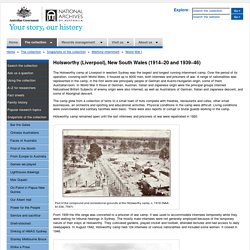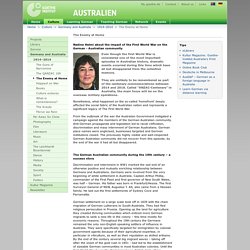

German internees in WWI Australia. From the 1850s German settlers escaping the rising nationalist sentiment in Germany began arriving in the Australian colonies looking to start a new life.

Port Adelaide was the point of arrival for the majority of German settlers. The Germans moved onto Western Australia, the Barossa Valley, the Riverina and South East Queensland where they found the regions suitable for wheat and dairy farming, the planting of vineyards and wine making. They formed close communities transforming the dry marginal environment into good farming land. The German Australians maintained strong cultural ties with their German heritage up until World War One. Holbrook silk wedding gown, c.1874. Wagga Travelling Trunk, 1880. Wagner’s Store, Jindera, NSW, c.2005. German Noodle Cutter, c.1880s. Noodle Cutter detail. Wendt Family, Trungley Hall, NSW, c.1900. Jindera Brass Band, c.1880-1910. Christening Font from Bethlehem Lutheran Church Jindera NSW, c.1872.
Lutheran Confirmation Certificate, 1863. World War I. The Holsworthy camp at Liverpool in western Sydney was the largest and longest running internment camp.

Over the period of its operation, covering both World Wars, it housed up to 6000 men, both internees and prisoners of war. A range of nationalities was represented in the camp, in the first world war principally people of German and Austro-Hungarian origin, some of them Australian-born. In World War II those of German, Austrian, Italian and Japanese origin were the principal groups interned. Naturalised British Subjects of enemy origin were also interned, as well as Australians of German, Italian and Japanese descent, and some of Aboriginal descent.
The camp grew from a collection of tents to a small town of huts complete with theatres, restaurants and cafes, other small businesses, an orchestra and sporting and educational activities. Holsworthy camp remained open until the last internees and prisoners of war were repatriated in 1920. Records. Australia - The Enemy at Home - Goethe-Institut.
Even though the first World War is considered one of the most important episodes in Australian history, dramatic events occurred during this time which have all but disappeared from the collective memory.

They are unlikely to be remembered as part of the centenary commemorations between 2014 and 2018. Called “ANZAC-Centenary” in Australia, the main focus will be on the overseas military operations. Nonetheless, what happened on the so-called ‘homefront’ deeply affected the social fabric of the Australian nation and represents a significant legacy of The First World War.
From the outbreak of the war the Australian Government instigated a campaign against the members of the German Australian community. Anti-German propaganda and legislation led to racial vilification, discrimination and mass internment of German Australians. The German Australian community during the 19th century – a success story The rise of the German Empire and its repercussions Creating the ‘enemy at home’ Deportation 1919. Battles - The Western Front. WW1 Battlefields of the Western Front. The long line of battlefields that makes up the Western Front runs through a wide variety of landscapes in south-west Belgium, north-eastern and eastern France.

The battle lines wind their way across the countryside from the sand dunes and flat, reclaimed sea level land on the Belgian coast in the north, to the mountain peaks at 1,400 metres (4,500 feet) above sea level in the Vosges mountain range at its southern end. From a geographical point of view the range of landscapes on which the Western Front battlefields were established include sand, clay, chalk and rock, rivers, canals, valleys and cliffs, ridges and mountains, plains, forests and swamps. When visiting the battlefields it can be seen how the geological make-up of the ground and the peculiarities of the landscape inevitably played a major part in influencing strategy, tactics, development of new weaponry and fighting techniques in the battles of the Western Front. Map of the 1914-1918 Western Front Battlefields Antwerp.